Tablet Weaving
Tablet weaving is a form of weaving which goes back to aprox. 1000 BC.
It is typically used to make long narrow trim for clothing or is used
to finish the edge of plain-woven cloth.
A plain weave uses fibers running the length of the cloth and a weft
fiber being run from side to side.
Tablet weaving is different in that each "row" of a fabric is not two
fibers deep (a plain weave) but can be 3, 4, 6 or any number of fibers
deep. The multiple fibers twist around each other; one being visable
on the top and one on the bottom while the others are hidden in the middle.
By using a multitude of colors and alternating the direction in which the
fibers rotate a pattern can be created on the cloth. There are many
techniques for getting a wide variety of patterns and texture.
Pictures of my weaving loom and some samples of woven cloth are coming
soon.
Patterns in the tablet woven material
This is from the book Step by Step Tablet Weaving, 1973, Marjorie and William Snow
Click on an image to get a full sized picture.

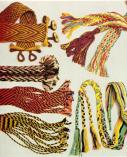
Some of my own work including my fluteholder
The first 2 pictures include a
simple patterned belt and a baldric which illustrates how two pieces of
tablet weaving can be woven together.

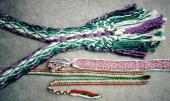


The last picture of a flute holder that I made. The weaving proceeded
from the center out towards both ends. The piece was then folded so that
both sides were woven into each other.

I then went from a normal tablet
weave to a pattern which allowed me to make the inside hollow (a plain
weave - ie 1/4 turn forward and then 1/4 turn back). This picture is
from the very start of the weaving.
Construction of the Loom
Here are some pictures which show how my loom is constructed. Mine was
made from a 6' piece of 1x6.
A 4' long board forms the base. At each end there is
a u-shaped piece to hold a rod which holds the threads. Some braces
are added to keep the ends upright.
At one end I tend to use an old bicycle innertube to provide tension
on the threads.
The work is typically started by having a rod at one end; around which the
threads are all wound. All of the loose ends get attached (by hook or crook
or glue? or magic?) at the other end. I've never quite found a nice and easy
way to do it. With some weaves you will have some threads twist more than
others and it would be nice to untwist them individually.
My quick 'n' dirty solution is just to tied the strings together. You will
note that the bar which is held by the innertube is actually made in 2 pieces
with a bit of dowel to hold them together. I used to try clamping the threads
between the two pieces but that didn't work well enough for my liking.
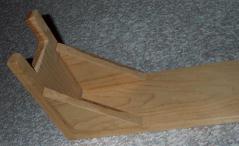
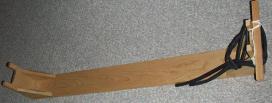
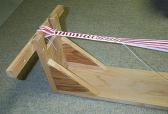

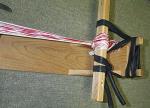
Back to my home page





